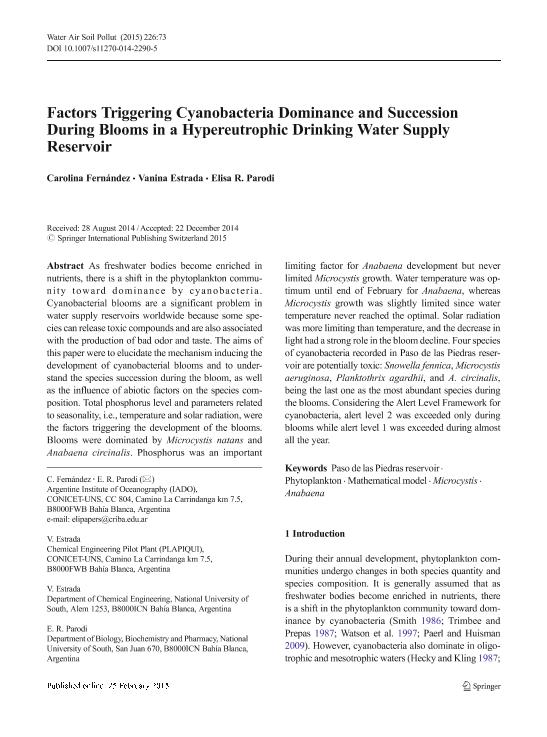Mostrar el registro sencillo del ítem
dc.contributor.author
Fernandez, Carolina

dc.contributor.author
Estrada, Vanina Gisela

dc.contributor.author
Parodi, Elisa Rosalia

dc.date.available
2017-02-03T21:45:37Z
dc.date.issued
2015-03
dc.identifier.citation
Fernandez, Carolina; Estrada, Vanina Gisela; Parodi, Elisa Rosalia; Factors Triggering Cyanobacteria Dominance and Succession During Blooms in a Hypereutrophic Drinking Water Supply Reservoir; Springer; Water, Air and Soil Pollution; 226; 3-2015; 73-85
dc.identifier.issn
0049-6979
dc.identifier.uri
http://hdl.handle.net/11336/12523
dc.description.abstract
As freshwater bodies become enriched in nutrients, there is a shift in the phytoplankton community toward dominance by cyanobacteria. Cyanobacterial blooms are a significant problem in water supply reservoirs worldwide because some species can release toxic compounds and are also associated with the production of bad odor and taste. The aims of this paper were to elucidate the mechanism inducing the development of cyanobacterial blooms and to understand the species succession during the bloom, as well as the influence of abiotic factors on the species composition. Total phosphorus level and parameters related to seasonality, i.e., temperature and solar radiation, were the factors triggering the development of the blooms. Blooms were dominated by Microcystis natans and Anabaena circinalis. Phosphorus was an important limiting factor for Anabaena development but never limited Microcystis growth. Water temperature was optimum until end of February for Anabaena, whereas Microcystis growth was slightly limited since water temperature never reached the optimal. Solar radiation was more limiting than temperature, and the decrease in light had a strong role in the bloom decline. Four species of cyanobacteria recorded in Paso de las Piedras reservoir are potentially toxic: Snowella fennica, Microcystis aeruginosa, Planktothrix agardhii, and A. circinalis, being the last one as the most abundant species during the blooms. Considering the Alert Level Framework for cyanobacteria, alert level 2 was exceeded only during blooms while alert level 1 was exceeded during almost all the year.
dc.format
application/pdf
dc.language.iso
eng
dc.publisher
Springer

dc.rights
info:eu-repo/semantics/openAccess
dc.rights.uri
https://creativecommons.org/licenses/by-nc-sa/2.5/ar/
dc.subject
Paso de Las Piedras Reservoir
dc.subject
Phytoplankton
dc.subject
Mathematical Model
dc.subject
Microcystis
dc.subject
Anabaena
dc.subject.classification
Ecología

dc.subject.classification
Ciencias Biológicas

dc.subject.classification
CIENCIAS NATURALES Y EXACTAS

dc.title
Factors Triggering Cyanobacteria Dominance and Succession During Blooms in a Hypereutrophic Drinking Water Supply Reservoir
dc.type
info:eu-repo/semantics/article
dc.type
info:ar-repo/semantics/artículo
dc.type
info:eu-repo/semantics/publishedVersion
dc.date.updated
2017-02-03T17:53:15Z
dc.identifier.eissn
1573-2932
dc.journal.volume
226
dc.journal.pagination
73-85
dc.journal.pais
Suiza

dc.journal.ciudad
Zurich
dc.description.fil
Fil: Fernandez, Carolina. Consejo Nacional de Investigaciones Científicas y Técnicas. Centro Científico Tecnológico Bahía Blanca. Instituto Argentino de Oceanografía (i); Argentina
dc.description.fil
Fil: Estrada, Vanina Gisela. Consejo Nacional de Investigaciones Científicas y Técnicas. Centro Científico Tecnológico Bahía Blanca. Planta Piloto de Ingeniería Química (i); Argentina. Universidad Nacional del Sur. Departamento de Ingenieria Quimica; Argentina
dc.description.fil
Fil: Parodi, Elisa Rosalia. Consejo Nacional de Investigaciones Científicas y Técnicas. Centro Científico Tecnológico Bahía Blanca. Instituto Argentino de Oceanografía (i); Argentina. Universidad Nacional del Sur. Departamento de Biología, Bioquímica y Farmacia; Argentina
dc.journal.title
Water, Air and Soil Pollution

dc.relation.alternativeid
info:eu-repo/semantics/altIdentifier/doi/http://link.springer.com/article/10.1007%2Fs11270-014-2290-5
dc.relation.alternativeid
info:eu-repo/semantics/altIdentifier/doi/http://dx.doi.org/10.1007/s11270-014-2290-5
Archivos asociados
